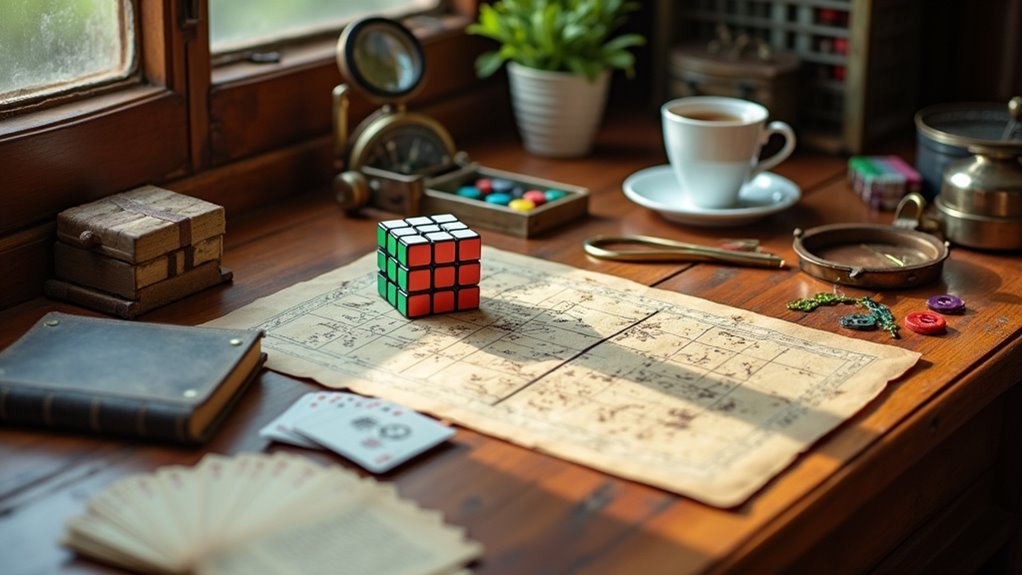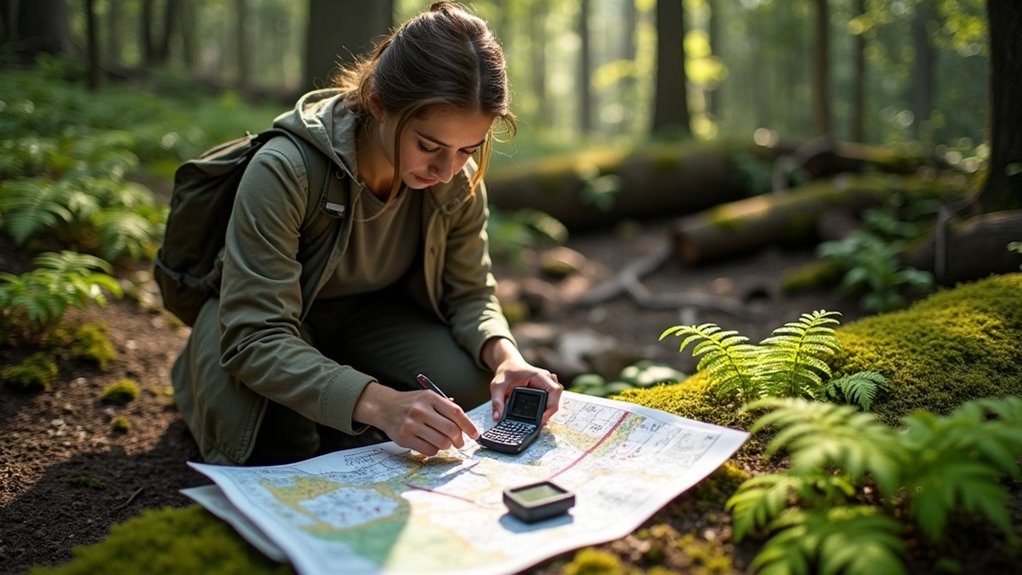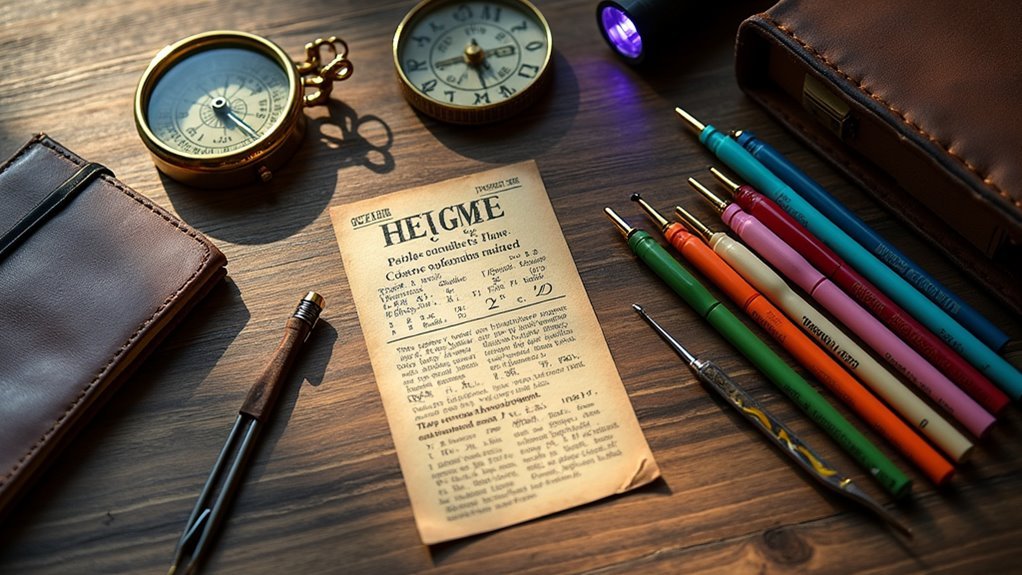Some of the links in this article may be affiliate links. If you make a purchase through these links, we may earn a small commission at no extra cost to you. Thank you.
Did you know that some of the world’s most dedicated treasure hunters spend hours solving complex puzzles just to find hidden containers in the woods? I’m talking about mystery cache geocaching, where coordinates are concealed behind ciphers, codes, and mathematical riddles. After struggling with these puzzles myself for years, I’ve finally cracked the code on how to approach them systematically. Trust me, there’s nothing quite like that moment when a seemingly impossible puzzle suddenly makes sense.
Common Types of Mystery Cache Puzzles

The mystery cache puzzles you’ll encounter in geocaching are like a mental playground for puzzle lovers.
I’ve found that there’s an amazing variety of challenges that puzzle writers create to test your wits before revealing those final GPS coordinates.
In my experience, substitution puzzles are probably the most common type, where letters become numbers or symbols.
Substitution puzzles transform ordinary letters into numerical values or cryptic symbols—a classic mental challenge for geocachers everywhere.
You’ll also frequently encounter telephone keypad puzzles—you know, where you map letters to numbers just like on your old phone.
Font substitution puzzles are another favorite in the geocaching community.
Don’t forget about number sequences and symbol-based challenges!
These features add an extra dimension of Adventure to the traditional cache hunt.
When I’m stuck on a Lab cache, I often look for patterns in counting elements first—it’s usually the key.
Mastering Substitution Ciphers
Among all the puzzle types I’ve tackled, substitution ciphers might be the most intimidating at first glance, but I’ve found they’re actually quite manageable once you know what to look for.
I’ve learned that mystery caches often use letter substitution, number substitution, and even telephone keypad or font substitution techniques. What’s helped me most is developing strong pattern recognition skills through practice.
The key to cracking these geocaching puzzles? Crib techniques.
I’ll analyze common patterns—like how “the” appears frequently in English—to get my first breakthrough.
It’s like solving a puzzle within a puzzle!
In my experience, dedicated practice with various decoding techniques pays off. I’ve gone from staring blankly at symbols to confidently tackling even complex substitution ciphers in mystery cache hunts.
Mathematical and Coordinate-Based Challenges

Mathematical challenges in geocaching often send my brain into overdrive, especially when I’m faced with indexed number sequences that need decoding.
Number sequences in geocaching puzzles can quickly transform my organized mind into mathematical chaos.
When using Official Geocaching apps or GPS units to track down mystery caches, precise coordinate calculations are absolutely essential.
I’ve found three key techniques that’ll save you hours of frustration:
- Always double-check your coordinate edits – a single digit mistake can send you searching 500 feet from the actual cache
- For telephone keypad puzzles, create a quick reference chart mapping letters to numbers
- With font substitution challenges, look for pattern repetitions that might reveal coordinate digits
In my experience, the Geocaching Help Center provides great resources for GPS-based puzzle solving, but nothing beats practicing with actual cache examples like GC2N4B8.
You’ll develop an intuition for these mathematical puzzles that’s invaluable in the field.
Steganography and Hidden Data Techniques
Steganography puzzles have completely changed the way I approach mystery caches, especially after spending countless hours deciphering hidden messages in GC2N4B8. When I find a thread of seemingly random text, I now look deeper for patterns like that elusive 11-digit word that might reveal coordinates.
Here’s my approach to hidden data techniques:
| Technique | Application | Difficulty |
|---|---|---|
| Text Pattern Analysis | Caching and related software | Medium |
| Crib Testing | API and GSAK integration | Hard |
| Metadata Examination | Trackable inventory on cache logs | Easy |
I’ve made something wrong assumptions before – like overlooking aspects of trackables embedded in puzzle text. If you’re having questions for my first steganography puzzle, seek feedback to assess your approach. The Guidelines and Adventure Lab inspiration tips can provide unexpected clues too!
Essential Tools for Puzzle Cache Solvers

The right tools can make or break your puzzle cache-solving experience, and I’ve learned this the hard way after countless hours staring at mysterious codes.
After trying to crack dozens of mystery caches, I’ve found three essential resources you shouldn’t go without:
- Video lessons – The 11 short tutorials taught me techniques for substitution puzzles that I would’ve never figured out on my own.
- PDF workbook and solution book – These are absolute lifesavers for practicing telephone keypad ciphers, indexed numbers, and those tricky font substitutions.
- Cribs – When I’m completely stuck with random text, having a known plaintext segment helps me identify patterns, especially when dealing with 11-digit words as potential keys.
Trust me, without these tools, you’ll waste hours on puzzles that could take minutes.
Pattern Recognition Strategies
Spotting patterns in geocache puzzles is like finding hidden trails in a dense forest—once you know what to look for, they’re everywhere.
When I’m stuck on a puzzle cache, I always check for repeating sequences first—those 11-digit patterns can be goldmines for cracking the code.
Frequency analysis is my go-to technique for substitution puzzles.
I count letter occurrences, knowing E, T, and A usually dominate English text.
For telephone keypad puzzles, I map the numbers to potential letters, which quickly narrows possibilities.
Visual distortions in font substitution puzzles require careful examination—I compare the altered shapes to standard fonts.
And don’t overlook structural patterns!
Word lengths and repeated motifs often reveal the puzzle’s framework, especially with indexed numbers.
These approaches have saved me countless hours of frustration.
Teamwork and Community Resources
Collaborative brainpower can crack the toughest geocache puzzles when your own mental resources run dry.
I’ve found that online forums are goldmines—the General Geocaching Discussions forum has over 1.3 million posts where you can ask your fellow geocachers for help with those frustrating ciphers.
Online forums are treasure troves of collective wisdom where geocachers worldwide stand ready to help you crack those maddening puzzle ciphers.
When you’re stuck, try these community approaches:
- Share your thoughts in the “How do I…?” forum where 366,600+ posts from veterans await to guide beginners through complex mysteries
- Place to discuss playing with trackable inventory on cache in the Trackables subforum (622.2K posts of collective wisdom!)
- Review any feedback from experts like Tim James who frequently post cribbing techniques
Don’t struggle alone—someone in the community has likely solved something similar before.
Avoiding Common Solving Pitfalls
While community support can save you from hours of frustration, I’ve noticed that even experienced geocachers fall into common traps when solving mystery caches.
I’ve learned (often the hard way!) not to overlook the importance of using a crib for decryption. Without one, you might waste time on random trial and error—just like those struggling with the GC2N4B8 puzzle.
Don’t ignore pattern analysis in ciphertext! An 11-digit word could be your breakthrough. Also, consider checking cache status before diving in—that puzzle from 2020 is archived, so why struggle with it? The official Geocaching® apps can help verify this.
Before creating theories, check the posting date for context. The Adventure Lab Guidelines and Help Center for Adventure contain wisdom that applies to mystery caches too—always review guidelines before posting about personal inventory on cache logs.
Advanced Techniques for Veteran Geocachers
Veteran geocachers often discover there’s a world of difference between solving basic mystery caches and tackling the truly devious puzzles.
I’ve found that mastering advanced substitution techniques is what separates casual players from puzzle masters.
Our course covers everything from keypad decoding to font substitution across 11 detailed video lessons.
When you’re stuck on those complex ciphers, try these advanced analysis methods:
- Use cribs to identify patterns in seemingly random ciphertext (this worked wonders for the GC2N4B8 puzzle!)
- Apply multi-layered decoding strategies for those geocache codes that combine different techniques
- Practice with indexed numbers and letter substitutions using our detailed workbook
I’ve seen veterans like Mike completely transform their puzzle solving approach with these techniques.
Trust me, there’s always a new trick to learn!
Frequently Asked Questions
Is Geocaching Still a Thing in 2025?
Like a phoenix from digital ashes, I’m seeing Geocaching Revival happening right now in 2025. Community Growth continues with Tech Evolution enhancing Global Appeal, especially during the post-pandemic Outdoor Revival we’re experiencing.
What Is a Mystery Cache in Geocaching?
I’ll tell you that mystery caches are puzzle types requiring decoding strategies to find hidden clues and solve coordinate riddles before locating the physical cache. They feature various enigma variations and challenge designs for adventure puzzles.
How Good Is Chatgpt at Solving Puzzles?
I’m good at simple puzzles, decent at logic challenges, but stumble with complexity. My algorithm strengths shine with patterns while my cognitive limits appear with multi-step geocaching puzzles requiring neural flexibility.
What Are the Three Main Rules of Geocaching?
I’ll tell you the geocaching principles I follow: swapping etiquette (leave items of equal value), logbook standards (always sign it), and environmental guidelines (leave no trace). These cache rules preserve our community code.